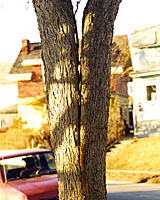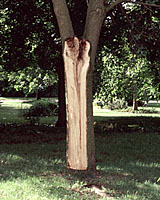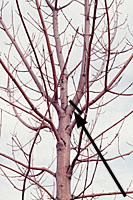Terry L. Ettinger Horticulture Consulting Services
Meeting The Needs Of Today With A Vision For The Future
Special Topics
Your Tree May Be in Trouble If . . .
Trunks or Branches are Cracked/Split
 Cracks at joints where two or more branches of equal diameter come together are cause for considerable concern,
at right.
Cracks at joints where two or more branches of equal diameter come together are cause for considerable concern,
at right.
While the intersection of these "co-dominant" trunks or branches may appear solid, they often hide internal seams of “imbedded” bark. Within these seams, there is often no connection of sound, structural wood between the trunks or branches. In fact, it's not uncommon for there to be large areas of decay where moisture has collected, often over many years.
 In many instances, one or more of these branches will eventually split, leaving gaping wound from which the
tree can not recover, at left.
In many instances, one or more of these branches will eventually split, leaving gaping wound from which the
tree can not recover, at left.
Co-dominant trunks are actually quite easy to identify in young trees. Simply note if there is more than one main "leader" stem. If there is, just cut one of them off - problem solved!
 This
correction is illustrated in the picture at right. The developing
co-dominant stem should be removed at the point indicated by the
arrow.
This
correction is illustrated in the picture at right. The developing
co-dominant stem should be removed at the point indicated by the
arrow.